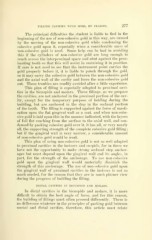Page 581 - My FlipBook
P. 581
PILLING CAVITIES WITH GOLD, BY CLASSES. 277 ;
The principal difficulties the student is liable to find in the
beginning of the use of non-cohesive gold in this way, are caused
by the moving of the non-cohesive gold while condensing the
cohesive gold upon it, especially when a considerable mass of
non-cohesive gold is used. Some help can be had in avoiding
this if the cylinders of non-cohesive gold are long enough to
reach across the interproximal space and abut against the prox-
imating tooth so that this will assist in sustaining it in position.
If care is not used to see that the instrument point carries the
gold properly before it, it is liable to punch through the gold,
or it may carry the cohesive gold between the non-cohesive gold
and the axial wall of the cavity and force the non-cohesive gold
out. These troubles are readily avoided after a little experience.
This plan of filling is especially adapted to proximal cavi-
ties in the bicuspids and molars. These fillings, as we prepare
the cavities, are not anchored in the proximal portion of the cav-
ity, except for the temporary purpose of holding during the
building, but are anchored in the step in the occlusal portion
of the tooth. The filling is supported against the force of masti-
cation upon the flat gingival wall as a seat, and when non-cohe-
sive gold is laid upon this in the manner indicated, with the layers
of foil flat reaching from the surface to the axial wall, and con-
densed by packing cohesive gold over it, it has all, or very nearly
all, the supporting strength of the complete cohesive gold filling
but if the gingival wall is very narrow, a considerable amount
of non-cohesive gold would be weak.
This plan of using non-cohesive gold is not so well adapted
to proximal cavities in the incisors and cuspids, for in these we
have not the opportunity to make strong occlusal step anchor-
ages but must depend upon the gingival wall and its angles, in
part, for the strength of the anchorage. To use non-cohesive
gold upon the gingival wall would materially diminish the
strength of this anchorage. The use of non-cohesive gold upon
the gingival wall of proximal cavities in the incisors is not so
much needed, for the reason that they are in much plainer view
during the progress of building the filling.
DISTAL CAVITIES IN BICUSPIDS AND MOLAES.
In distal cavities in the bicuspids and molars, it is more
difficult to obtain the best angle of force, and for this reason,
the building of fillings must often proceed differently. There is
no difference whatever in the principles of packing gold between
mesial and distal cavities, therefore, this article must relate


